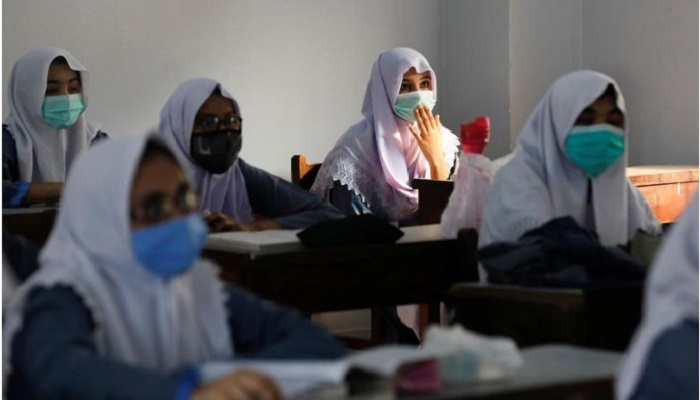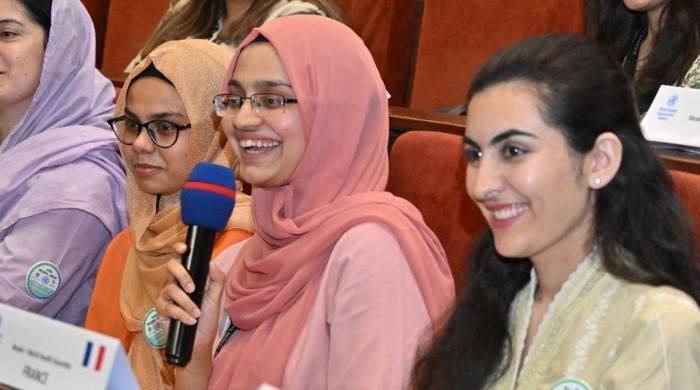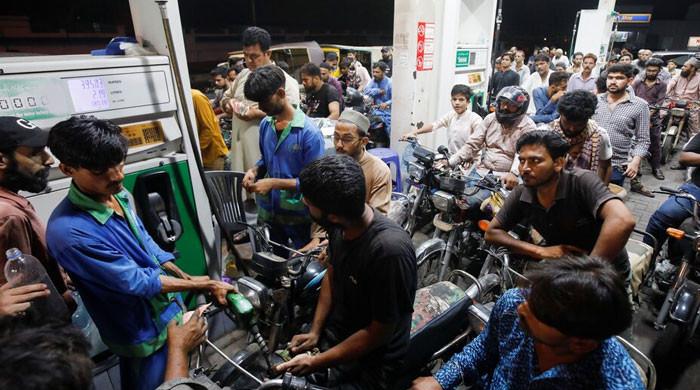A robotics challenge and STEAM learning at public schools
Ministry of Federal Education is testing STEAM – Science, Technology, Engineering, Arts and Mathematics – enrichment programme in public schools in Islamabad
October 20, 2021

The minister leaned forward and asked, “What are you building?” The girl responded: “a robotic arm.” This exchange did not happen at an engineering university or a fancy private school. This was a conversation with an 8th grader at one of 30 out of approximately 220 eligible government schools in Islamabad that the Ministry of Federal Education and Professional Training (MoFEPT) is using as testbeds for a STEAM – short for Science, Technology, Engineering, Arts and Mathematics – enrichment programme before the concept is scaled to cover all schools in the federal capital area.
Even better was the atmosphere in the classroom minutes before the federal minister’s arrival. Children were working at round tables in groups of five to six and the classroom was buzzing with excitement and activity. Some were sitting, others excitedly going around their tables finding the Lego piece, sensor or motor they needed. Others were studying the manual for building instructions for the robotic arm. Up until 10 years ago, such enrichment activities used to be the exclusive purview of a select few private schools or after-school programmes by local ed-techs.
There are plenty of things to criticise every day, but occasionally we come across a bright spot that deserves to be celebrated. This STEAM education initiative for public schools in the federal capital qualifies as one of them. This programme was a priority for Minister Shafqat Mahmood but had been languishing in the purgatory that is the government’s purchasing process for a long time until Waseem Ajmal, joint secretary of the MoFEPT, pulled it out and shepherded it to its conclusion.
To the layperson it may look like the connection of STEAM activities like robotics programmes using Lego kits with the curriculum is only tenuous. The basic blocks and plates are characterised by their sizes, which are specified in terms of the knobs (or dots) usually on their top surface. Searching for the right-sized piece reinforces counting and multiplication tables (ranging in size from 2x2 up to 16x16 and many in between). Building larger pieces from smaller ones is a physical demonstration of fractions. Organising the large number of pieces ahead of building reinforces concepts of set theory and search / sorting algorithms. Following build instructions requires an understanding of angles and 2D and 3D geometry. All these concepts connect to topics from mathematics.
Robotics projects are often electrified and motorised, which provides an opportunity for demonstrating physics and engineering concepts of structural integrity, torque, electricity, sensors, motors, actuators, force vectors, and simple machines (levers, incline planes etc).
Programmable projects introduce students to practical computer science concepts like programming, flowcharts, input/output and logic. Government middle schools that go up to grade 8 are generally not equipped with computer labs. Yet, starting next academic year, Computer Studies is being introduced as a subject for grades 6 to 8. Ideally, middle schools will need to be equipped with computers for students to use, to spare them the agony of learning computer studies from books alone. Unless that happens, this STEAM programme will probably be more relevant for teaching students basic computer concepts than the Computer Studies subject itself.
There are many aspects of such STEAM activities that teachers can leverage to connect with subject matter in science, computer science, mathematics and even art classes. Collectively, these activities teach creativity, design, problem solving through project-based learning. Since these activities are conducted in medium-sized groups, they help develop teamwork and collaborative working skills. Any private school would milk this programme for all its worth in advertising and promotional campaigns.
Over the next year, schools that are part of this pilot phase will have to converge on an instructional model that works best for each, depending on their student and teacher profiles, enrollment strength etc. This is new territory to most schools in countries like ours and will involve some trial, error and iteration. With the kinks worked out by the start of the next school year, possibly with the support of external partners, this STEAM programme will be scaled up to all schools in the ICT area.
I am usually wary of ‘innovative’ technology-based programmes for schools. Experience shows that too many times the technology – usually selected for the wow-factor it provides and not for improving classroom learning and culture – ends up being an expensive liability. I am reminded of a quick exchange with a provincial education minister a few years ago who insisted on introducing a scheme to make schools “smart.” When asked to explain what he meant by that he was clueless but figured it meant installing LED screens in classrooms. I blurted that he should instead try and make children smarter. Too often, non-educationists put technology in front of education when it should be the other way around. This STEAM programme is refreshing because it allows education to lead technology. It complements what is being taught in classrooms.
As an engineering graduate from another decade myself, when attitudes of many (but not all) towards women electing careers in engineering were generally dismissive, STEAM education for girls in particular is a cause that is very close to my heart. That is why I want to make a special mention of the schoolgirls I met, who were positively ready to burst with excitement! I asked them if they had ever used Lego blocks before. Only one was new to Lego-like block building systems, while the others had different levels of prior experience.
I asked the STEAM solution provider if they see a difference in adoption and participation between girls and boys. They validated what educationists already know – girls are hesitant at first, but only until they become familiar with the platform provided their teachers maintain the same expectations from them as they do from boys. Many girls initially face a mental hurdle as a barrier to entry into ‘male’ fields of study but one that STEAM experiences like this can help them overcome quickly.
A March 7, 2015 article in The Economist (‘Nature plus nurture’) reported that girls feel confident of their ability in Math and think they can be better than boys but when the questions are formulated in terms stereotypically associated with boys (for example: calculate the fuel consumption of a car) their confidence shrinks. These are finer factors that matter to self-efficacy and learning and subtly push boys and girls to choose stereotypical career paths.
In another July 20, 2019 article, The Economist describes how former Communist East European countries have historically had a smaller gender gap, with women scientists and engineers as role models which created a strong pipeline that remains intact to this day. We need to close our own gender gap in STEAM and connect the pipeline of schoolgirls with universities and vocational training institutes. To that end, a study conducted by Microsoft a few years ago showed that introducing girls to female role models in tech increases girls’ interest in these areas. This can be accomplished by inviting speakers at schools or meeting them on field trips to universities and vocational institutes. Middle and high schools should be connected to tertiary institutes within their reach to introduce children to tech-skill based programs and careers.
A few years ago, a survey of the distribution of PhD holders in Pakistan showed that the vast majority is clustered in and around the Islamabad-Rawalpindi twin-city area. This STEAM programme also provides a rare opportunity for study to education researchers at a significant scale. In the long term, beyond this particular programme, the Islamabad Capital area could and should be established as a national center for research and innovation for the development of best practices in K-12 education. The findings of these research studies should be shared publicly to inform future public education policies at the center and in provinces that may lack the capacity to conduct such research themselves, all the while remaining in line with the 18th Amendment.
The writer is the technical adviser to the MoFEPT. Views are her own.
Originally published in The News











